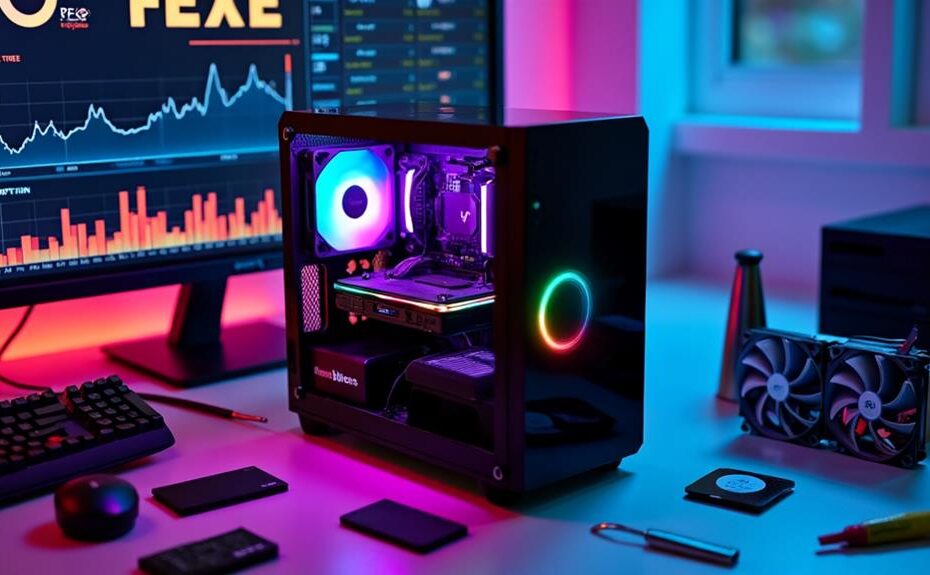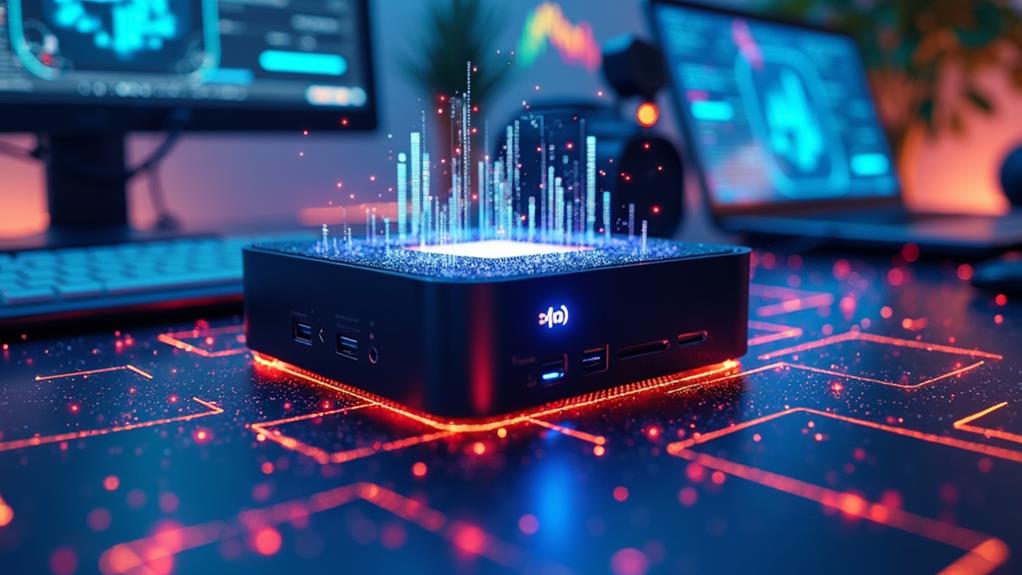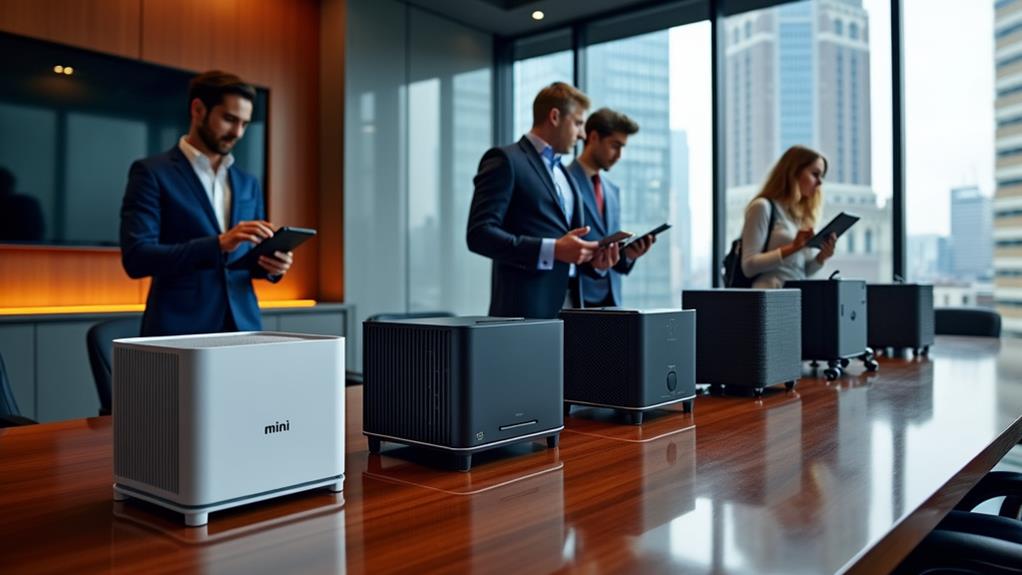



To enhance your Mini PC's performance over time, start with regular software and driver updates to improve functionality and security. Upgrade to SSDs for faster boot and access times, and increase RAM to at least 8GB for better multitasking. Utilize effective overclocking techniques, ensuring proper cooling solutions to manage heat. Refine power management settings for maximum efficiency. Regularly monitor system performance and perform cleaning to prevent overheating. Finally, troubleshoot common issues promptly to maintain ideal operation. Following these practices can considerably boost and maintain performance levels—more insights await you to further refine your system.
Key Takeaways
- Regularly update software and drivers to apply critical security patches and enhance performance.
- Upgrade to SSDs for significantly faster read/write speeds and reduced boot times.
- Increase RAM to at least 8GB for improved multitasking and responsiveness.
- Optimize cooling solutions and airflow to prevent overheating and maintain system performance.
- Monitor system performance regularly to identify bottlenecks and implement timely upgrades.
Regular Software and Driver Updates
Keeping your Mini PC running smoothly hinges greatly on regular software and driver updates. These updates not only apply critical security patches but also enhance overall performance, ensuring you get the most from your device. Regular software updates are essential, so make it a habit to check for and install updates for your operating system. This practice minimizes vulnerabilities and improves your system's functionality. Additionally, since mini PCs can support higher capacity RAM and more slots than laptops, ensuring that your software is refined can help you fully utilize these capabilities, particularly for multitasking and resource-intensive applications, as highlighted in performance comparisons.
Equally important, you need to keep your drivers updated. This includes those for your GPU, motherboard, and any peripherals. Updated drivers facilitate compatibility with the latest software and enhance performance tailored to your hardware. Utilizing automated tools, like Windows Update, can greatly streamline the update process, reducing manual oversight.
Don't overlook the manufacturer's website either; it often provides specific firmware updates that can bolster system stability and introduce new functionality. Schedule routine checks—aim for at least once a month—to review and apply updates. This proactive approach prevents performance degradation associated with outdated software, ensuring your Mini PC operates at peak efficiency. Ultimately, committing to regular software and driver updates is a crucial step in maintaining an ideal computing environment.
Effective Overclocking Techniques
After confirming your Mini PC is up-to-date with the latest software and drivers, you can explore the performance-enhancing potential of overclocking. Mini PCs, known for their compact and energy-efficient designs, can greatly benefit from overclocking, especially when handling demanding tasks like gaming and video editing. Overclocking a Mini PC involves increasing the internal clock speed beyond factory settings, which can yield considerable performance boosts. Start by entering the BIOS/UEFI to incrementally adjust the CPU clock speed and voltage settings. It's vital to monitor temperatures and system stability using tools like HW Monitor and Prime95 throughout this process.
Implementing effective cooling solutions is fundamental; high-quality air or liquid cooling systems can manage the increased heat generated during overclocking. Verify your power supply has a minimum wattage of 90W to support the enhanced performance. To streamline the overclocking process, consider utilizing third-party software like MSI Afterburner or Intel XTU. These tools offer user-friendly interfaces for real-time adjustments and performance monitoring.
Lastly, always have a solid backup and recovery plan in place before you start overclocking. This will safeguard your data and system settings, allowing for a quick restoration in case of instability or hardware failure.
Cooling Solutions and Airflow Management
Effective cooling solutions and proper airflow management are essential for maintaining peak performance in Mini PCs, especially when overclocking. Start by considering passive cooling options like heatsinks, which can effectively regulate temperatures in low-power systems without the noise of active cooling. However, if you're using higher-performance CPUs, you might need to incorporate additional fans—provided your Mini PC's design allows for it. Utilizing efficient cooling systems can further enhance thermal management within the compact chassis.
Ensure that your Mini PC has adequate airflow by keeping it several inches away from walls and obstructions. This simple measure can greatly enhance cooling efficiency. Regular maintenance is also critical; dust buildup can lead to overheating and performance degradation. Make it a habit to clean dust filters and internal components periodically.
Moreover, monitoring CPU temperatures with software tools helps you assess the effectiveness of your cooling solutions. If temperatures start to rise, you can make timely adjustments to prevent thermal throttling or damage. By combining these strategies, you can optimize cooling solutions and airflow management, ensuring your Mini PC remains efficient and responsive over time.
Storage Upgrades With SSDS
Upgrading to a solid-state drive (SSD) can dramatically enhance your Mini PC's performance, transforming not just speed but overall efficiency. Unlike traditional hard disk drives (HDDs), SSDs offer read/write speeds that are 5 to 20 times faster, considerably reducing boot times to under 20 seconds. This means you'll experience quicker access to your system and applications, as HDDs typically take 30-60 seconds.
If your Mini PC supports M.2 NVMe SSDs, you can take advantage of even higher data transfer rates, reaching up to 3,500 MB/s. This is particularly beneficial for resource-intensive applications, making multitasking smoother and application load times remarkably faster. The user experience improves considerably, especially during demanding tasks.
To guarantee peak performance from your SSD, regularly monitor and optimize its health using tools like CrystalDiskInfo. This proactive approach helps maintain top performance and prolongs the drive's lifespan. Overall, storage upgrades with SSDs are essential for maximizing your Mini PC's performance, making it a worthy investment for anyone looking to enhance their computing experience.
RAM Enhancements for Better Performance
Boosting your Mini PC's performance often hinges on enhancing its RAM. Start by upgrading your RAM to a minimum of 8GB, as this greatly improves multitasking capabilities and overall system responsiveness. For memory-intensive applications, having sufficient RAM is essential. Consider utilizing dual-channel memory configurations by installing matching RAM sticks; this can enhance data transfer rates, leading to faster performance.
When selecting RAM, opt for higher speeds, such as DDR4 3200 MHz or faster. This maximizes bandwidth and efficiency, especially beneficial for applications that require quick data access. Regularly monitoring your RAM usage through performance tools is important. This practice helps identify bottlenecks, enabling you to make timely upgrades as software demands evolve.
Lastly, while focusing on RAM enhancements, remember that integrating solid-state drives (SSDs) can further reduce load times. SSDs, combined with increased RAM, create a synergistic effect that boosts your Mini PC's performance. Keep in mind that higher RAM can also influence power consumption, so balance your upgrades to guarantee you're getting the most out of your Mini PC without unnecessary energy costs.
Power Management Settings Optimization
While optimizing your Mini PC's performance, fine-tuning power management settings can make a considerable difference in responsiveness and efficiency. Start by adjusting the power plan settings in Windows to "High Performance." This prevents the CPU from throttling down during low-demand periods, guaranteeing consistent performance when you need it.
Next, explore advanced power management options. Disabling USB selective suspend settings can help maintain connectivity by preventing USB devices from entering low power states. In the BIOS/UEFI, configuring processor power management settings, such as disabling C-states, enables your CPU to operate at higher performance levels, although it may increase power consumption.
Additionally, consider enabling power-saving features for the GPU. This adjustment helps balance performance with energy efficiency, especially during less demanding tasks. Regularly monitor and adjust these power management settings based on your usage patterns to optimize overall system performance and prolong the battery life of portable mini PCs.
Lastly, verify your Mini PC has proper cooling to prevent overheating, which can negatively impact performance when these settings are optimized. By implementing these strategies, you can greatly enhance your Mini PC's capabilities over time.
Monitoring System Performance
Monitoring system performance is vital for ensuring your Mini PC operates at peak efficiency. To start, utilize performance monitoring tools like Task Manager or Resource Monitor to identify resource-intensive processes that may be hindering overall performance. Regularly checking system logs can reveal underlying hardware or software issues that contribute to performance degradation over time.
In addition, implement specialized tools such as HWMonitor or CPU-Z to track important metrics like CPU temperatures, voltages, and clock speeds. Keeping these parameters within safe limits is essential for ideal operation. Don't overlook disk usage; optimizing storage through regular defragmentation for HDDs or utilizing SSD optimization tools can greatly enhance read/write speeds.
Setting up alerts for system performance metrics is also a smart move. These alerts will notify you of any notable changes, allowing for timely troubleshooting before minor issues escalate into major problems. By actively engaging in monitoring system performance, you can maintain your Mini PC's capability and longevity, ensuring you get the best out of your investment. Regular checks and strategic adjustments will lead to sustained performance improvements over time.
Cleaning and Maintenance Practices
To maintain the performance gains achieved through effective monitoring, regular cleaning and maintenance practices are key. Start by dusting and cleaning both the exterior and interior components of your Mini PC. Use compressed air to remove dirt and debris that can obstruct airflow, leading to overheating. This simple cleaning routine can greatly enhance your system's heat management.
Schedule software updates for your operating system and applications to guarantee peak performance and security. Outdated software can slow down your system and introduce vulnerabilities. Additionally, perform regular disk cleanup and defragmentation if you're using an HDD. This frees up space and enhances data access speeds, keeping your Mini PC running efficiently.
It's also essential to monitor system temperatures using software tools. Identifying overheating issues early allows for timely intervention, preserving hardware longevity. Finally, consider replacing the thermal paste on the CPU every few years. This improves heat dissipation, helping maintain peak operating temperatures and enhancing overall performance. By adhering to these cleaning and maintenance practices, you'll guarantee your Mini PC continues to operate at peak efficiency over time.
Troubleshooting Common Issues
Many users encounter common issues with their Mini PCs that can hinder performance and stability. To effectively tackle these problems, start by monitoring system temperatures using tools like HW Monitor or CPU-Z. Overheating can severely impact performance, so keeping an eye on thermal metrics is vital for ideal operation.
Next, explore your system logs. Look for error messages and performance bottlenecks that might indicate hardware or software conflicts. These insights can help you pinpoint underlying issues affecting your Mini PC's functionality.
Periodically conducting stress tests with software like Prime95 is also essential. This allows you to evaluate system stability and detect potential overclocking-related problems that may arise from performance adjustments.
Don't forget to keep all drivers and operating system updates current. Outdated software can lead to compatibility issues, which often result in system instability or degraded performance.
Lastly, utilize backup and recovery software to create a system image. This enables quick restoration of your settings and data in case of crashes or significant performance issues, further aiding in troubleshooting common issues effectively.
Disclosure: As an Amazon Associate, I earn from qualifying purchases.







